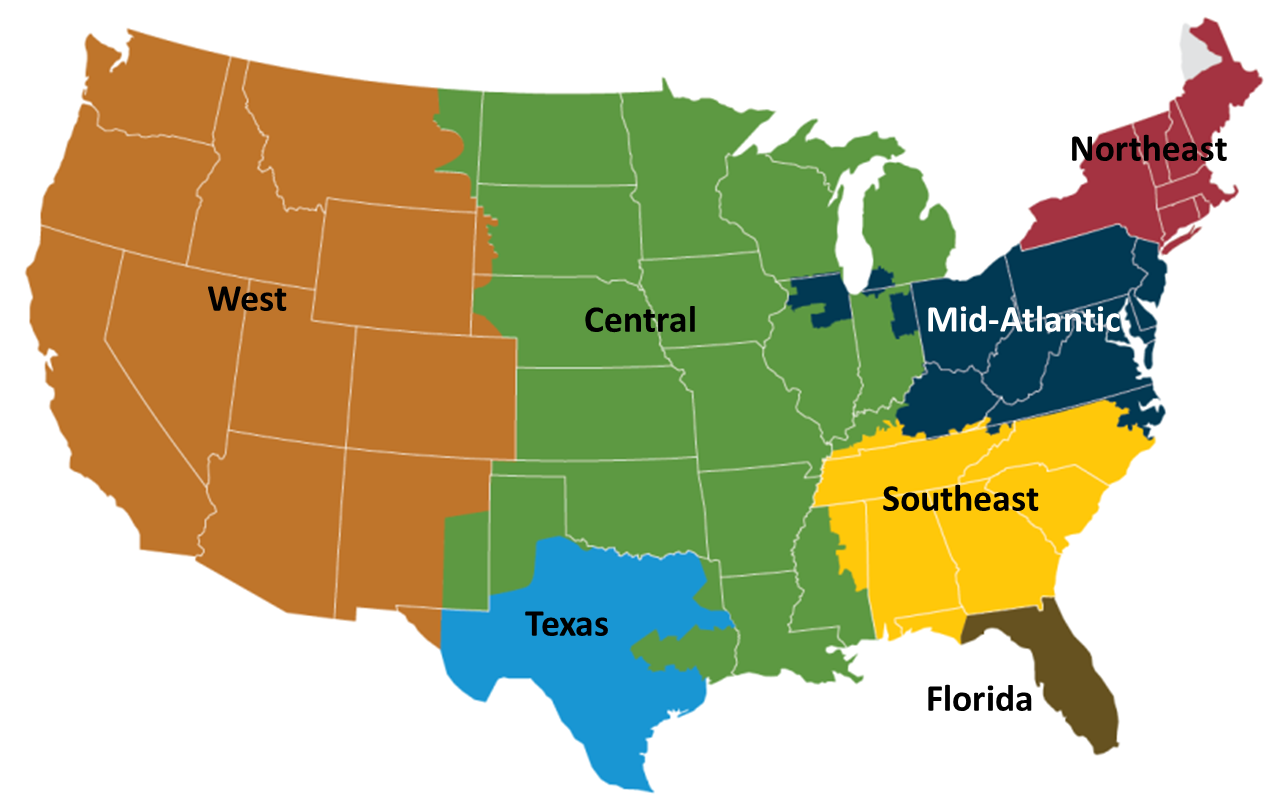
Electricity Monthly Update
Resource Use: September 2025
Supply and fuel consumption
In this section, we look at the resources used to produce electricity. Generating units are chosen to run primarily on their operating costs, of which fuel costs account for the lion's share. Therefore, we present below, electricity generation output by fuel type and generator type. Since the generator/fuel mix of utilities varies significantly by region, we also present generation output by region.
Generation output by region
Net electricity generation in the United States increased 2.4% compared to September 2024. Most areas of the country, except for the West and Florida, saw an increase in electricity generation compared to the previous year. The largest percent increases in electricity generation compared to the previous year were seen in Texas (up 4.5%) and the Southeast (up 3.8%). Both areas saw higher average temperatures during the month this September compared to September 2024. This led to an increase in electricity demand for residential cooling and thus, an increase in year-over-year electricity generation in these two regions.
The change in electricity generation from coal was mixed throughout the country, with the MidAtlantic, Central, Southeast, and Florida all seeing an increase in coal generation compared to September 2024, while the Northeast, West, and Texas all saw a decrease in coal generation. The change in electricity generation from natural gas was also mixed throughout the country. The MidAtlantic, Central, West, and Texas all saw an increase in natural gas generation, while the Northeast, Southeast, and Florida all saw a decrease in natural gas generation compared to the previous September.
Fossil fuel consumption by region
The chart above compares coal consumption in September 2024 and September 2025 by region and the second tab compares natural gas consumption by region over the same period. Changes in coal and natural gas consumption were similar to their respective changes in coal and natural gas generation.
The third tab presents the change in the relative share of fossil fuel consumption by fuel type on a percentage basis, calculated using equivalent energy content (Btu). This highlights changes in the relative market shares of coal, natural gas, and petroleum. The MidAtlantic, Central, Southeast, and Florida all saw their shares of coal increase at the expense of natural gas, while the West and Texas saw their shares of natural gas increase at the expense of coal.
The fourth tab presents the change in coal and natural gas consumption on an energy content basis by region. The changes in total coal and natural gas consumption were similar to the changes seen in total coal and natural gas net generation in each region.
Fossil fuel prices
To gain some insight into the changing pattern of consumption of fossil fuels over the past year, we look at relative monthly average spot fuel prices. A common way to compare fuel prices is on an equivalent $/MMBtu basis as shown in the chart above. The average price of natural gas at Henry Hub increased from the previous month, going from $2.92/MMBtu in August 2025 to $2.96/MMBtu in September 2025. The natural gas price for New York City (Transco Zone 6 NY) decreased from the previous month, going from $2.26/MMBtu in August 2025 to $1.84/MMBtu in September 2025. The average spot price of Central Appalachian coal increased slightly from the previous month, going from $3.13/MMBtu in August 2025 to $3.14/MMBtu in September 2025.
A fuel price comparison based on equivalent energy content ($/MMBtu) does not reflect differences in energy conversion efficiency (heat rate) among different types of generators. Gas-fired combined-cycle units tend to be more efficient than coal-fired steam units. The second tab shows coal and natural gas prices on an equivalent energy content and efficiency basis. The Henry Hub natural gas price ($23.73/MWh) saw an increase from the previous month ($23.37/MWh) and was below the Central Appalachian coal price ($33.91/MWh) in September 2025. The price of natural gas at New York City ($14.74/MWh) saw a decrease compared to the previous month ($18.10/MWh) and was below the Central Appalachian coal price ($33.91/MWh).
The conversion shown in this chart is done for illustrative purposes only. The competition between coal and natural gas to produce electricity is more complex. It involves delivered prices and emission costs, the terms of fuel supply contracts, and the workings of fuel markets.
